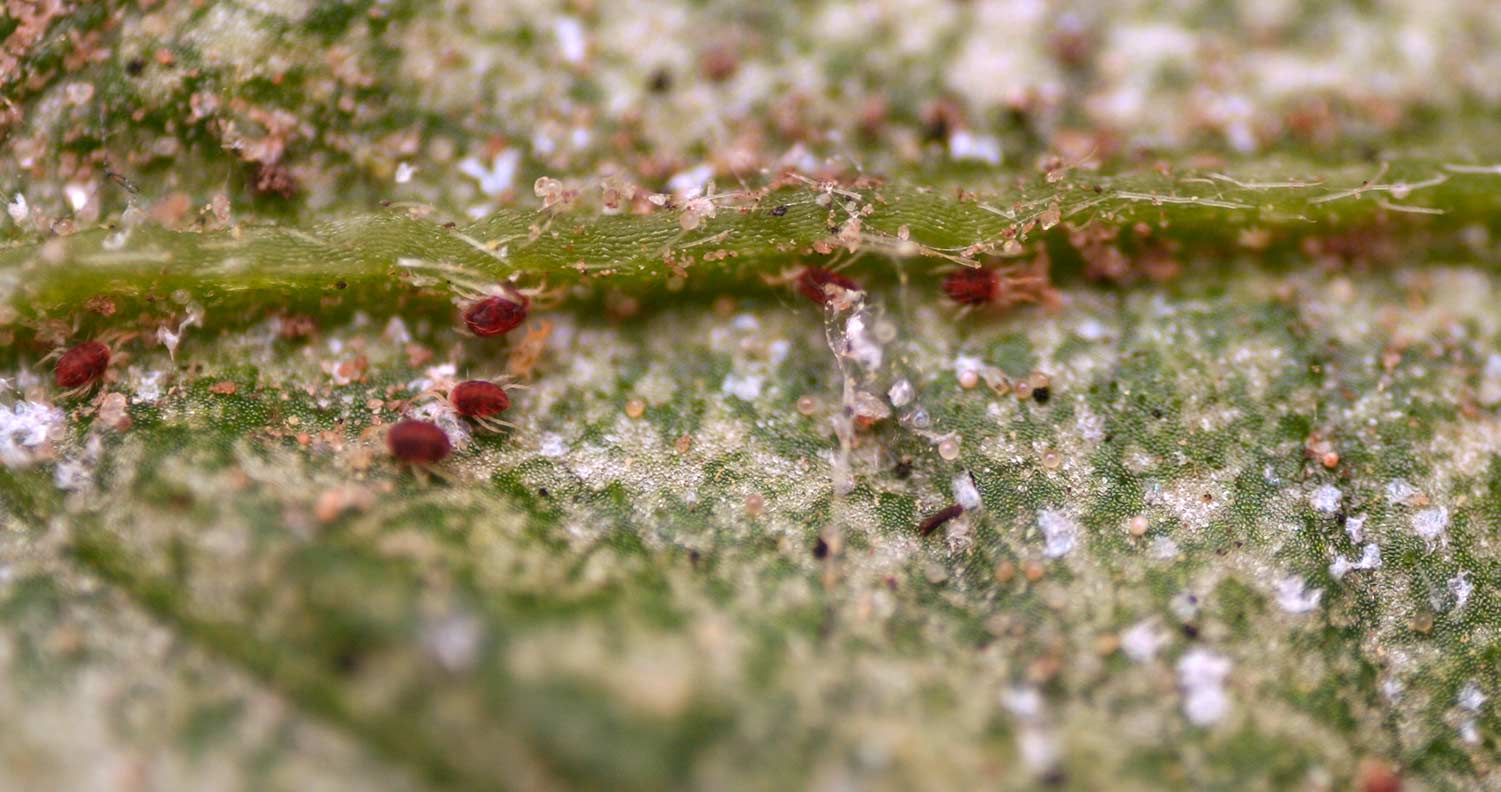If you’ve identified that spider mites are the creatures damaging your plants, you might be wondering “Where the hell do spider mites come from?” After all, these little buggers seem to destroy plants with malevolent intent.
While these pests are small in size, they can cause some serious damage to both leaves and fruit. If you’ve ever seen the stippling and discoloration they can cause, you know what I’m talking about.
But don’t fear, you can deal with these pests. However, before you do so, it’s important to learn about this pest’s life cycle and further understand how they harm plants. Once you know a bit more, you can figure out how to best control spider mites and kill them.
It’s time to make these microscopic pests a bit less mysterious.
What are Spider Mites?
While you may call them bugs, spider mites aren’t insects. They’re more closely related to spiders with their eight legs and lack of antennae.
However, you might not be able to see all these features because spider mites are tiny! The adult mites are 1/50 of an inch long and juveniles are even smaller. That means they’re hard to see with the naked eye. If you want to get a better look at these pests, grab a magnifying glass.
There are hundreds of different species of spider mites. Some of these species feed on just a couple of types of plants and others are less picky eaters. While some species thrive in cooler weather, the vast majority breed and feed when the weather is hot.
One of the most common types of these pests is the two-spotted spider mite. This mite feeds on over 200 species of plants and is a major pest for a variety of ornamental and agricultural plants. It thrives in hot weather, especially in dusty areas and during times of drought.
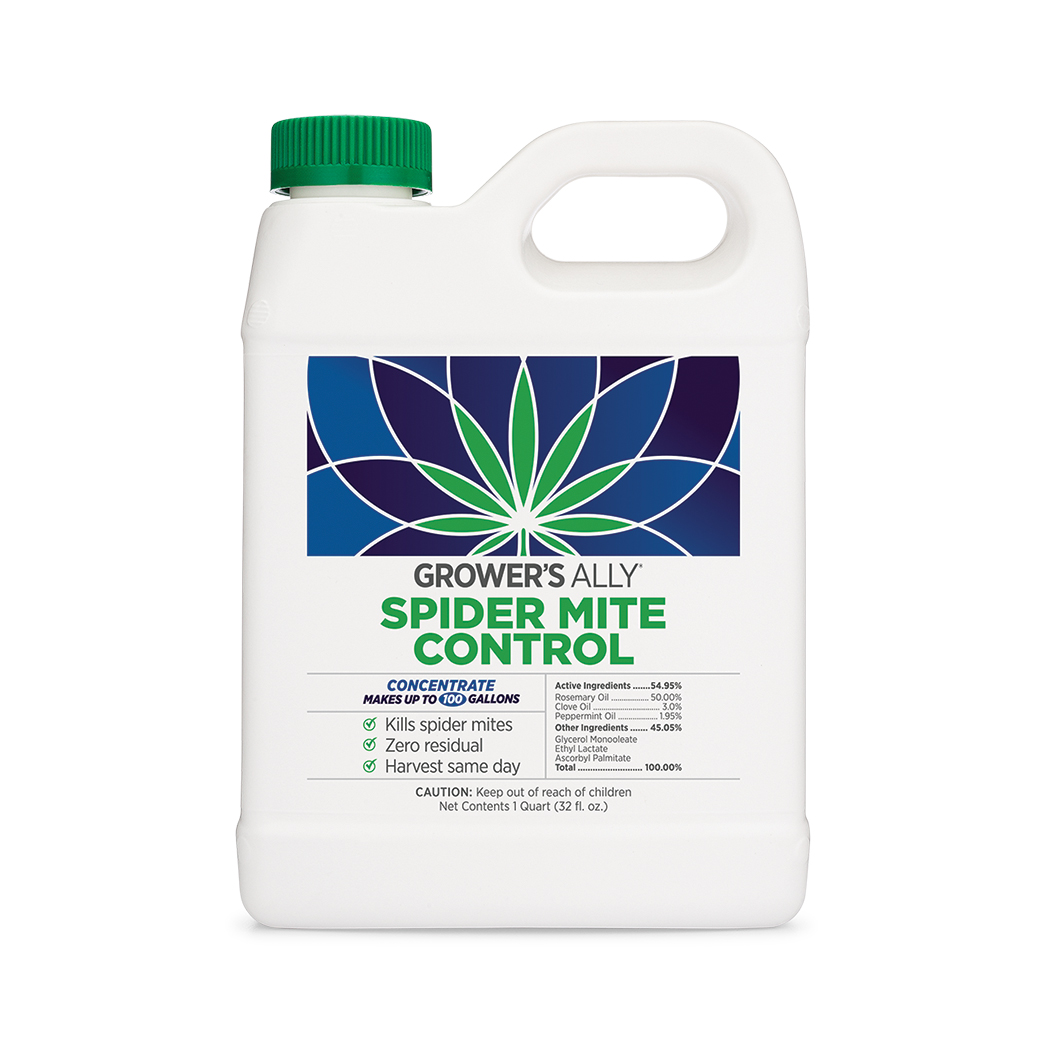
Grower’s Ally Spider Mite Control
All natural and safe spider mite control by Grower’s Ally is one of the absolute best ways to kill spider mites.
Use it on your plants in any stage; vegetative, blooming, or fruiting.
Controls spider mites and russet mites, in both adult and nymph stages.
All About the Spider Mite Life Cycle
Now that we know the basics about these pests, let’s learn a bit more about their life cycle.
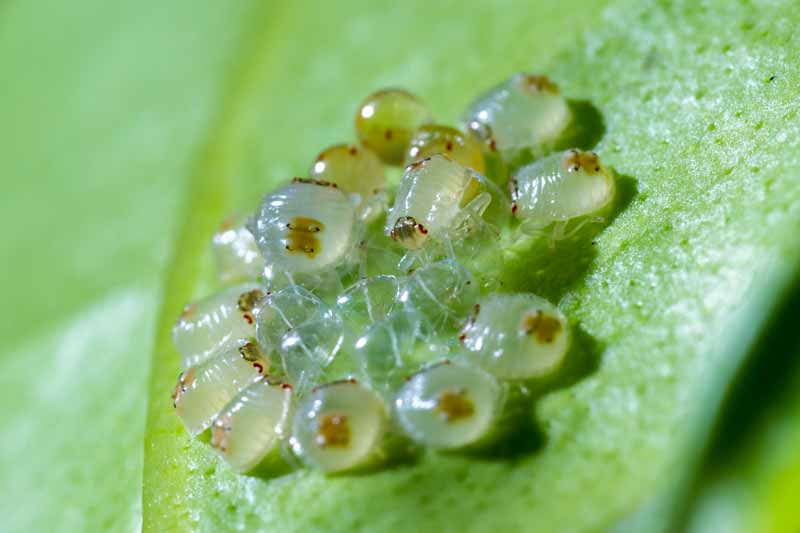
Spider mites start their lives as eggs (see photo above) which adults lay on host plants. Depending on environmental conditions and the species of mite, these eggs hatch into larvae within a few days to a few weeks. Larvae only have six legs, rather than eight.
The larvae feed on the host plant for a few days before turning into eight-legged nymphs. These nymphs then feed for a few more days before turning into a second nymph stage. Once again, this nymph feeds for a few days and then turns into an adult.
You might have noticed a pattern here; the mites only take a few days to complete each life stage. This means that they can go from an egg to an adult in as little as one week, and you could have an infestation on your hands before you know it! It is important to note that cooler and wetter weather leads to slower growth in spider mite populations.
While most types of spider mites thrive in hot weather, they don’t disappear during colder weather. During the winter, spider mites remain as eggs or dormant adults.
Now we can answer the question of where these pests come from. While it may seem like spider mites appear out of nowhere, they may have been around your plants all along. However, numbers don’t become noticeable until weather conditions become favorable.
It’s also possible that they have traveled in on infested plant material or on the shoes and clothes of workers. They can even blow in with the wind!
What Damage Do Spider Mites Inflict?
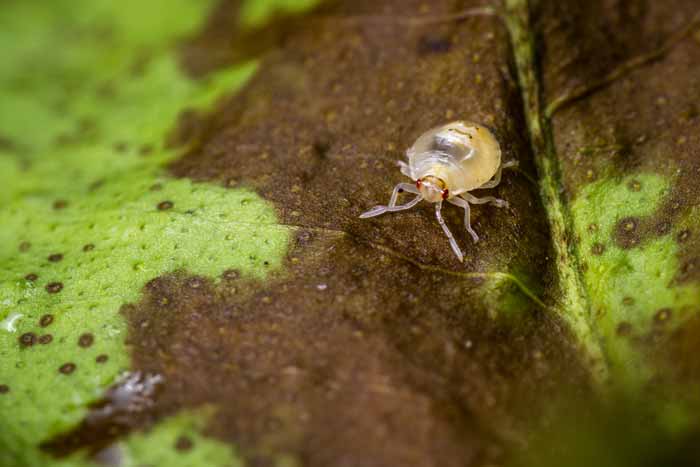
Since these pests are so small, you might see the damage they cause before you actually see the pests themselves. Therefore, you can scout your plants for damage as well as the spider mites themselves.
Spider mites have sucking mouthparts which they use to drink the liquid contents of plant cells. This leads to many small dots on plant tissue — an appearance that’s known as stippling.
When many spider mites feed at once, a large number of dots morph together to cause discoloration. When you have an infestation, you may notice that your plant’s leaves appear bronze, yellow, or silver. Some species also feed on various fruits causing stippling on the fruit.
One more sign of spider mites is their namesake webbing. Once populations increase, the mites begin to form visible silk webs on or under plant leaves and stems. This webbing can help distinguish them from other small pests including aphids and thrips.
If you see webbing, make sure to check your plants for spider mites. You can look for the pests with your eyes, or place a piece of paper underneath the plant. If you give the plant a good shake, spider mites will fall onto the piece of paper, where they will be easier to see.
As you’ve probably guessed, plants don’t love having the life sucked out of them. If infestations get out of control, plants may die. So, it’s best to take action when you see the first sign of spider mites.
What Conditions Favor Spider Mites?
Most species of spider mites thrive in hot, dry conditions. As you might have guessed, spider mite infestations often pop up in times of drought. In indoor growing areas, spider mites are more likely to become a problem on underwatered plants.
Over-applying nutrients can also make your plants more susceptible to spider mites. If you’ve applied too much nitrogen, your plants are more likely to be attacked by spider mites and other pests. Wondering why?
Excessive nitrogen leads to small compounds known as”funny proteins.” These proteins don’t help the plant, but they do make plant sap sweeter, leading to an increased attack of sucking insects like spider mites. To avoid this problem, apply a balanced spectrum of nutrients, and only apply what your plant needs. There can be too much of a good thing.
Spider mites are also more difficult to control on larger plants and in areas with large numbers of plants. Since they reproduce rapidly, it’s harder to detect and treat them when they have more plant tissue to live and feed on.
How To Get Rid of Spider Mites on Plants, Including During Flowering
When controlling spider mites, you have three main options. These include physical, biological, and chemical methods.
If you’re trying to practice integrated pest management, you always want to start with the least invasive control method. That means attempting physical controls then biological controls and finally chemical controls.
Physical Control
If you notice an issue with these pests before they get out of control, you may be able to get rid of them using physical methods. However, this method really only works if you have a few small plants since you’ll be unable to find the mites in a larger growing area.
If the mites are limited to a small number of leaves, you might be able to prune off the infected tissue. Before you start removing leaves, make sure you think about how this pruning will affect your plant’s growth.
Biological Control
Fortunately, spider mites have a number of different natural enemies. If you’re growing outdoors, these predators often keep spider mite numbers in check. You can also buy and release some of these natural predators. With that said, these predators work better as a preventative than as a control method.
While spider mites are enemies, there are other types of mites!
Predatory mites can’t eliminate an infestation, but they may be able to prevent one from occurring in the first place by preying on small populations. Since predatory mites feed on spider mites, they’ll leave once they wipe out the pests and don’t have anything to eat. To keep the predatory mites around, you’ll need to release them more than once.
Chemical Control
If physical and biological controls aren’t cutting it, you can turn to chemical control. As with all types of chemical control, there are both organic and synthetic chemicals available for spider mite control. And within each group, there are lots of different products.
When you’re choosing a product, there’s a number of factors to consider. Of course, the product needs to kill the pests! However, you also want to consider the cost of the product, how often you need to apply it, its re-entry interval, and how harmful it is to humans and beneficial insects.
Neem Oil for Spider Mites
There are a lot of pesticides available in the world, and choosing one can be overwhelming. When you’re picking a pesticide for spider mites, be aware that some types of pesticides, including carbaryl, organophosphates, and, pyrethroids can actually increase spider mite populations.
Why? These pesticides kill natural predators that are present in outdoor growing areas. They also increase the nitrogen content in leaves, which leaves plants more susceptible to attacks.
Horticultural oils like neem oil are better options. Neem oil is derived from the seeds of the neem tree. It’s been used around the world for hundreds of years to keep away pests.
Neem oil works by suffocating pests such as aphids, mealybugs, and spider mites. In order for it to kill pets, it has to come into direct contact with them.
Azadirachtin: A Neem Derivative
Azadirachtin is a compound derived from seeds of the neem tree. While azadirachtin is derived from neem seeds, it controls pests differently than neem oil.
The major way azadirachtin works is by disrupting pest hormones. Azadirachtin has a similar structure to a group of hormones known as ecdysones. When insects come into contact with this pesticide, their natural hormones are disrupted.
When ecdysones are disturbed, the affected pests cannot complete metamorphosis. That means spider mites can’t turn into adults, their life cycle is disrupted, and populations plummet.
A final way azadirachtin works as a pesticide is by repelling pests.
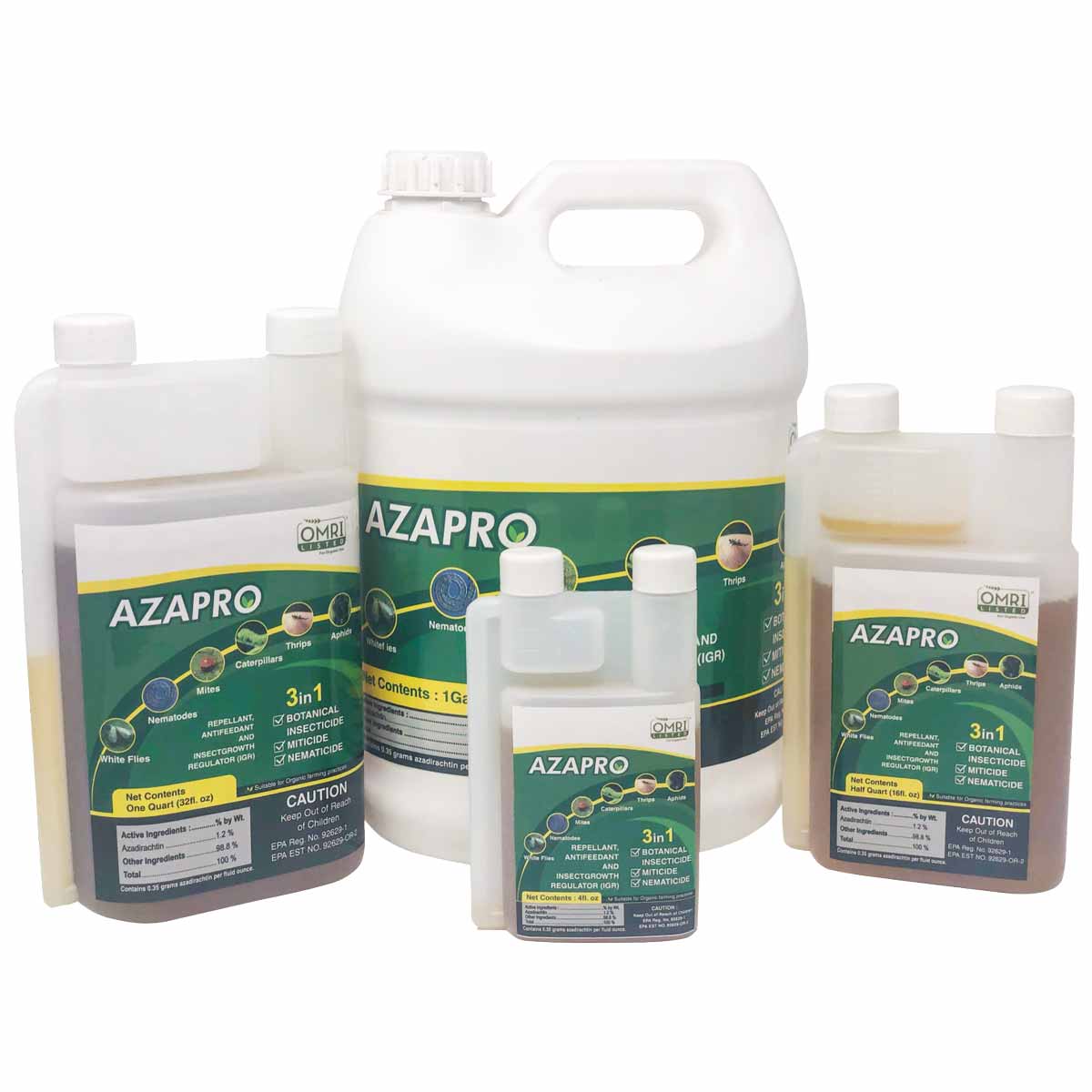
Azapro
The highest quality Azadirachtin extract provides better leaf penetration, and pest lifecycle disruption.
It is a full featured insect growth regulator, anti-feedant, ovi-position deterrent
Why is AzaPro Best Spider Mite Killer?
Another way azadirachtin controls pests is by stopping feeding. Once spider mites ingest the compound, they stop eating and eventually die.
AzaPro contains a highly-bioactive and concentrated form of azadirachtin. As you’ve read above, azadirachtin is excellent at disrupting the spider mite life cycle and squashing infestations. And Azapro kills a wide variety of leaf eating pests beyond spider mites. It kills thrips, white fly, aphids, caterpillars, nematodes and more.
Another cool thing about AzaPro is its ability to move from one side of a leaf to another. When you spray crops with a product, it’s hard to coat all sides of the leaves. Unfortunately, spider mites and other pests love to hide on the undersides of leaves.
AzaPro makes it easy to reach these hiding pests. After you spray the product on the top of a leaf, it moves through the leaf to the underside. This action is called translaminar movement.
While this product covers all sides of a leaf, it doesn’t leave oily residues. This is because it contains less carrier oil than competing products. AzaPro also emulsifies easily.
Azapro Pest Life Cycle Disruption
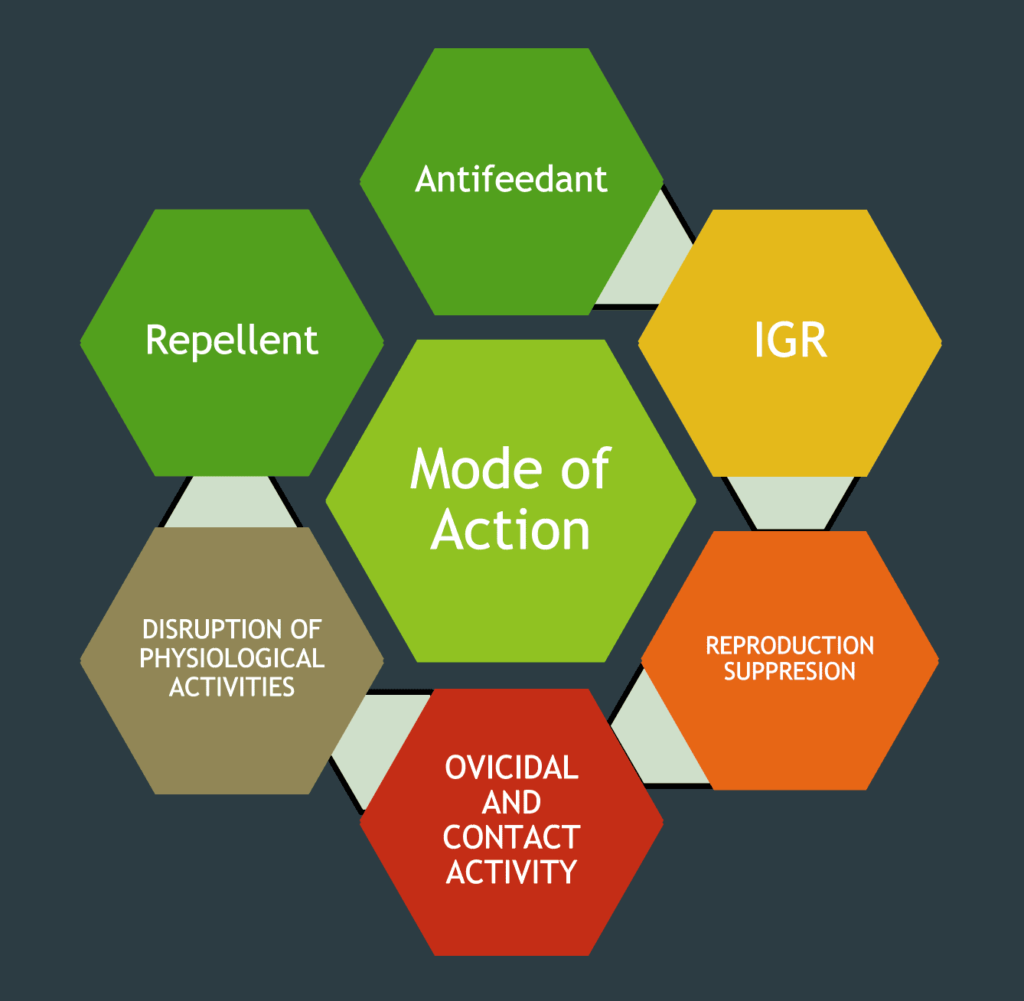
Another great aspect of AzaPro is it that it’s safe for humans and the environment when used properly. Not only does this mean that you can use it with little worry, but it also makes scheduling your tasks easier. It’s also OMRI listed.
AzaPro’s re-entry interval is four hours, which means it’s safe to re-enter an area four hours after someone sprays. This means that you can spray and complete other tasks like pruning or fertilizing all in the same day. It also has a zero-day pre-harvest interval, so you can safely spray and harvest the same day.
Wrapping Up
To review, spider mites are tiny pests that attack plant leaves and fruit with their sucking mouthparts. Remember, these pests are not insects.
They thrive in hot and dry conditions, and they multiply rapidly in the right conditions. To keep these pests under control, it’s important to always be looking for them and take action as soon as you see some.
You can use physical, biological, and chemical control methods against spider mites. However, if infestations are severe, chemical control might be your only option.
When it comes time to pick a chemical control, look no further than AzaPro. Not only is it effective at killing these pests, but it’s also safe for you and your plants.
Resources
Explaining Azadirachtin and Neem
Pest Control Designed by Nature
